Impact of prior cancer history on survival in brain malignancy: A propensity score-adjusted, population-based study
- PMID: 38389401
- PMCID: PMC10884616
- DOI: 10.1002/cnr2.1984
Impact of prior cancer history on survival in brain malignancy: A propensity score-adjusted, population-based study
Abstract
Background: Individuals with a Prior Cancer History (PCH) are often excluded from clinical trials. However, a growing body of evidence suggests that prior cancer history does not present adverse outcomes on cancer patients. The evidence on the survival of brain cancer patients in this regard remains widely unknown.
Methods: We conducted a retrospective cohort study to estimate the prevalence and impact of prior cancer on survival of patients diagnosed with brain cancer. Data of patients who were diagnosed with brain cancer as their first or second primary malignancy between 2000 and 2019 were extracted from the Surveillance, Epidemiology, and End Results (SEER) database. Propensity Score Matching (PSM) was used to ensure comparable baseline characteristics among the patients. Survival analysis was conducted using the Kaplan-Meier method, as well as multivariate Cox proportional hazard and multivariate competing risk models.
Results: Out of 42 726 patients, 1189 (2.78%) had PCH. Genitourinary (40.4%), Breast (13.6%), Hematologic and Lymphatic (11.4%), and Gastrointestinal malignancies (11.3%) were the most common types of prior cancer. PCH served as a significant risk factor for Overall Survival (OS) (Adjusted Hazard Ratio [AHR] 1.26; 95% CI [1.15-1.39]; p < .001) but did not have a statistically significant impact on Brain Cancer-Specific Survival (BCSS) (AHR 0.97; 95% CI [0.88-1.07]; p = .54). Glioblastoma exhibited the most substantial and statistically significant impact on survival as compared to other histological types. Of all the organs systems, only prior Gastrointestinal and Hematologic and Lymphatic malignancies had a statistically significant impact on OS of patients.
Conclusion: Our findings indicate that PCH does not exert a substantial impact on the survival of brain cancer patients, except in cases involving gastrointestinal or hematologic and lymphatic PCH, or when the brain cancer is glioblastoma.
Keywords: brain cancer; cancer-specific survival; overall survival; prior cancer.
© 2024 The Authors. Cancer Reports published by Wiley Periodicals LLC.
Conflict of interest statement
The authors have stated explicitly that there are no conflicts of interest in connection with this article.
Figures





Similar articles
-
Impact of prior cancer history on survival of patients with gastric cancer.Eur J Surg Oncol. 2021 Sep;47(9):2286-2294. doi: 10.1016/j.ejso.2021.02.007. Epub 2021 Feb 11. Eur J Surg Oncol. 2021. PMID: 33632589
-
Survival and risk factors for metastatic colorectal cancer patients with a history of prior malignancy.Sci Rep. 2025 Feb 3;15(1):4045. doi: 10.1038/s41598-025-88555-7. Sci Rep. 2025. PMID: 39900612 Free PMC article.
-
Impact of prior cancer history on the survival of patients with larynx cancer.BMC Cancer. 2020 Nov 23;20(1):1137. doi: 10.1186/s12885-020-07634-2. BMC Cancer. 2020. PMID: 33228622 Free PMC article.
-
Prior malignancy impact on survival outcomes of glioblastoma multiforme; population-based study.Int J Neurosci. 2019 May;129(5):447-454. doi: 10.1080/00207454.2018.1538989. Epub 2018 Dec 4. Int J Neurosci. 2019. PMID: 30366515
-
Prior malignancies in patients harboring glioblastoma: an institutional case-study of 2164 patients.J Neurooncol. 2017 Sep;134(2):245-251. doi: 10.1007/s11060-017-2512-y. Epub 2017 May 27. J Neurooncol. 2017. PMID: 28551847 Review.
Cited by
-
Development and validation of a machine learning-based survival prediction model for Asian glioblastoma patients using the SEER database and Chinese data.Sci Rep. 2025 Aug 24;15(1):31114. doi: 10.1038/s41598-025-15553-0. Sci Rep. 2025. PMID: 40850977 Free PMC article.
References
-
- McNeill KA. Epidemiology of brain tumors. Neurol Clin. 2016;34(4):981‐998. - PubMed
-
- Cancer Stat Facts: Brain and Other Nervous System Cancer . https://seer.cancer.gov/statfacts/html/brain.html
MeSH terms
LinkOut - more resources
Full Text Sources
Medical
Miscellaneous

